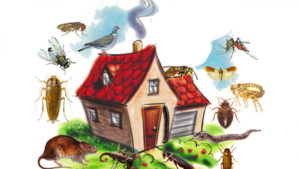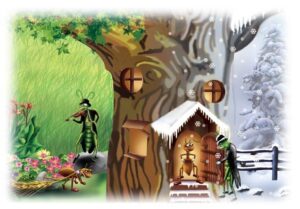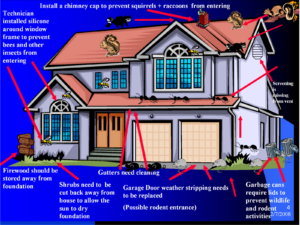September 22nd, marked the fall equinox this year; Where Summer blasts our days with her last hot breaths, and Fall creeps in with his first cool evening breezes.
It’s the time when, days and nights begin as equals and where days slowly shorten and nights lengthen.
It is the summer’s great last heat, It is the fall’s first chill: They meet.
–Sarah Morgan Bryan Piatt
It all has to do with our swiftly tilting planet. The marking of Fall traditionally comes with the equinox, when the Sun’s path through the sky takes it from rising due East to setting due West. Since our seasons are caused by the tilt of Earth’s axis relative to its orbital plane, the equinox roughly marks the transition from longer periods of daylight to shorter ones or vice versa.
So what does this have to do with the world of insects? The two biggest environmental changes insects are genetically wired to perceive are the length of days (daylight) and change in temperature. The shortening of daylight hours and the beginning of cooler evenings, in the fall, signals the time for winter preparation. Unfortunately, your warm home may be irresistible to insects and other pests seeking shelter from the cold.
Even soil-dwelling insects, receive the “signal” to migrate deeper into soil. Their cue is soil temperature – as soil gets cooler, the insects dig down deeper.
In warmer climates, cool evening tempe ratures and the advent of the rainy season often sounds the starting bell for the annual insect race indoors and unfortunately, your warm home may be irresistible to insects seeking shelter from the cold.
ratures and the advent of the rainy season often sounds the starting bell for the annual insect race indoors and unfortunately, your warm home may be irresistible to insects seeking shelter from the cold.
The Top 5 Fall Pests Looking to Make Your House, Their Home.
Rodents. Rodent control and exclusion should be your number one fall priority, as mice and rats scurry to find warm, dry places to over-winter. Walls, closets, pantries, sub-areas, basements and attics are inviting spaces for these pests. Species to watch for: deer mice, house mice, roof or tree rats.
Flies. Fly populations are at their height in early fall because they have had all year to increase their numbers. As temperatures drop, some flies look for a retreat inside homes from the cool weather outside. The south- and west-facing walls of your home may attract flies in search of heat. If those flies are already overwintering, a warm day may bring them out of hiding. It’s important to remember that some flies can cause bigger problems than just irritating buzzing; they have the potential to carry diseases such as tuberculosis, typhoid, dysentery, and diarrhea. Species to watch for: cluster flies, fruit flies, house flies.
Stinging Insects. As fall approaches, stinging insects such as yellow jackets and other wasps can be quite active. After working all summer to create the largest nest possible, it becomes a struggle to feed so many with temperatures dropping and food supplies dwindling. Under such stress, the colony can become hostile and individuals can split off and start looking for nesting sites that will provide better shelter and more access to food sources. Species to watch for: yellow jackets, honey bees.
Ants. Cool autumn weather may bring ant trails indoors. Ants sometimes move their colonies into the walls of the home or beneath a slab of foundation to escape the chill. Effective ant control is about locating the nest and preventing ants from getting inside. Species to watch for: carpenter ants, pavement ants, odorous house ants.
Occasional Invaders. This time of year can include a shopping list of unique fall insects, commonly referred to as occasional invaders. This includes stink bugs, boxelders and ladybugs. These pests enter homes in search of overwintering sites where they can wait out the winter. While these insects typically do not cause structural damage, they are generally considered a nuisance.
Species to watch for: stink bugs, lady bugs, boxelders, spiders.
We humans need to “take a lesson” from indu strious insects, whose genetic imperative it is to continually prepare for life’s challenges, in order to assure its’ species successful survival. Remember Asoeps Fable about the Ant and the Grasshopper? See Disney’s 1934 version here: https://www.youtube.com/watch?v=3V9uL_ruafU
strious insects, whose genetic imperative it is to continually prepare for life’s challenges, in order to assure its’ species successful survival. Remember Asoeps Fable about the Ant and the Grasshopper? See Disney’s 1934 version here: https://www.youtube.com/watch?v=3V9uL_ruafU
Now is the time to prepare our homes for the Fall and Winter insect invasions.
- Screen attic vents and openings to chimneys, and any other areas where homes may be open to the outdoors, like mail slots and animal doors.
- Keep basements, attics and crawl spaces well ventilated and dry. Pests are attracted to areas of moisture, something they need to survive.
- Seal cracks and crevices on the outside of the home using caulk and steel wool. Pay close attention to where utility pipes enter the structure. Some rodents can fit through a hole the size of a dime.
- Keep kitchen counters clean, store food in airtight containers and dispose of garbage regularly in sealed receptacles.
- Replace weather-stripping and repair lose mortar around the foundation and windows. These are easy ways to keep not only pests, but also cold air out of the house.
- Store firewood at least 20 feet away from the house and keep shrubbery trimmed. Removing areas where pests can hide near your home can reduce the chance of them finding a way inside.
- Install door sweeps and repair damaged screens. Torn window screens and cracks under doors are an ideal entry point for household pests.
- Inspect items such as boxes of decorations, package deliveries, and grocery bags before bringing them indoors. Pests can find creative ways to get inside a home. Shake out or inspect anything that has been left or stored outside.
- Avoid leaving pets’ food dishes out for long periods of time. Pests don’t discriminate between people food and cat food.
- Have a proper outdoor drainage system. Installing gutters or repairing an existing system will help draw water and moisture away from your home, preventing any leaks or build up that might attract pests.

 800-901-1102
800-901-1102
0 Comments